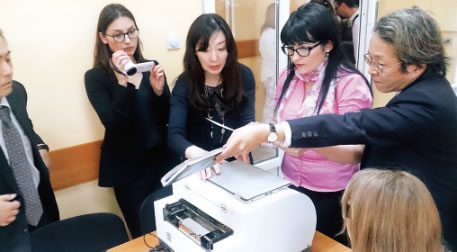Stories from the Field 12
Transforming Education with
Braille Printers
– Supporting education and work opportunities for visually impaired
persons in Serbia

Mr. Hideaki Kaneko of Nippon Telesoft Co., Ltd. with visually impaired persons of the Union of the Blind of Serbia (Photo: Shuzo Fujimoto)
The Republic of Serbia, one of the countries of the former Yugoslavia in Eastern Europe, is a landlocked country about the size of Hokkaido and with a population of approximately 7.16 million people, equivalent to the population of Saitama Prefecture.
The Union of the Blind of Serbia is an organization that seeks to protect the rights of the blind and visually impaired in Serbia. It provides a variety of support services for free to its approximately 12,000 registered members, such services include managing and operating of braille libraries, publishing of braille books and magazines, printing of text books for visually impaired students for free, training on how to read braille, and supporting people with visual impairments to find employment.
This Union had provided support using braille printers since 1999, but these printers were more than 20 years old and many had become unusable. The remaining usable printers had problems with slow printing speed and frequent paper jamming. Moreover, braille printers were only installed at the Union’s headquarters. This meant that people with visual impairments living in rural areas could not immediately use braille printers when they needed braille publications.
In order to improve the social lives of these people with visual impairments in Serbia, Japan decided to provide the Grant Assistance for Grass-Roots Human Security Projects1 through financial support to the Union of the Blind of Serbia for purchase of high-quality braille printers and braille pin displays.

Staff members of Nippon Telesoft explains how to operate a Braille printer to members of the Union of the Blind of Serbia. (Photo: Shuzo Fujimoto)
This Union used this Grant to purchase and install 5 new braille printers and 19 braille pin displays. A braille pin display is an electronic device that can display data from the computer and USB memory in braille format. This allows users to check the contents before printing, and to input braille documents as braille data. Until now, people with visual impairments always had to print out documents using a braille printer to acquire information. Now, using braille pin display, they can access information quickly while contributing to the saving of valuable braille printing paper.
Mr. Hideaki Kaneko, the president of Nippon Telesoft Co., Ltd., the manufacturing company that manufactured the braille printers and pin displays sent to Serbia, says, “Our products can print braille and ink documents simultaneously, so that people who cannot read braille can also understand the contents. Not all teachers at schools for the visually impaired can understand braille. Our printers are also extremely quiet, which makes them particularly well suited for educational institutions. Extreme shortage of braille textbooks is part of the reason for the low transition rate to higher education and severe employment situations of visually impaired persons in Serbia. I believe further introduction of braille printers will help improve the educational environment in the country.”
The braille printers that the Union of the Blind of Serbia purchased were manufactured in the Kumamoto plant. However, in April 2016, just before the delivery of the printers, the plant was hit by the Kumamoto Earthquake. In order to deliver the printers on time, the company could not wait for the plant to re-open. The company decided to prioritize the assembling of the printers and, when they were assembled, its employees used their own cars to deliver the printers to Fukuoka from Kumamoto, so that they were safely shipped to Serbia on time.
Looking back on that time, Mr. Kaneko says, “The printers were safely delivered to Serbia by overcoming the disaster, and the experience of this delivery of printers was very emotional for us. In Serbia, they offered us words of sympathy for the Kumamoto Earthquake and we were grateful to them for their words.”
The five braille printers were installed in five locations of the Union of the Blind, including its headquarters. At the handover ceremony in Belgrade on May 16, 2016, a technician from Nippon Telesoft also attended and provided training on how to use the equipment to the employees of the Union.
Mr. Kaneko says, “My impression is that people with visual impairments in Serbia have a strong desire to participate in society and to advance in their education. There are still many places where braille printers are needed, in addition to the five locations where they were installed this time. I hope to continue to work with the Union of the Blind of Serbia to introduce more printers in Serbia.”
Braille printers and braille pin displays are the kind of devices you can hardly see. However, such devices contribute to the creation of educational and employment opportunities for persons with visual impairments in Serbia, and thus help improve their social welfare.
*1 Grant assistance for the purpose of socio-economic development in developing countries based on the concept of human security, through which the necessary funds are provided for relatively small-scale projects that directly contribute to people at the grassroots level.
<< Previous Page
Main Text | Statistics and Reference Materials | Stories from the Field | Master Techniques from Japan to the World | ODA Topics
